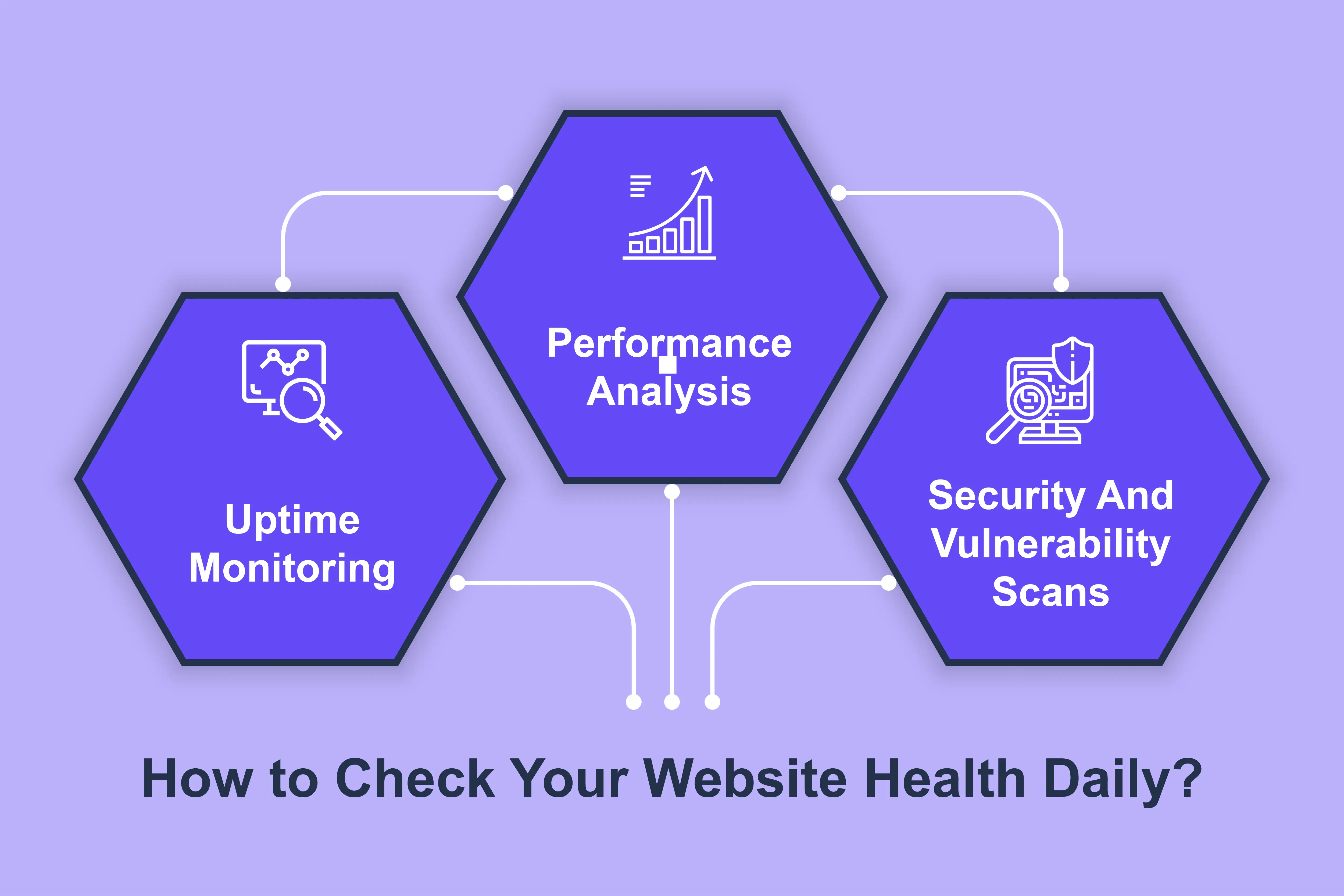Written By :Gigde
Mon Dec 04 2023
5 min read
Check Your Website Health With Easy Steps

Is your website having trouble attracting visitors and generating leads? Are you ready to discover the key to digital success and accelerate online growth? There's no reason to seek elsewhere! It's time to check your website's health and give it the boost it deserves.
A solid online presence is crucial for every organization to flourish in today's digital world. Your website acts as the virtual face of your brand, so it must be in good working order. But how can you check website performance, determine its current state and provide the appropriate treatment?
Join us as we probe your website's core to assess its functionality, user experience, and search engine exposure. Every detail will be painstakingly examined by our team of experts, who will also look for areas for development and any obstacles.
“Learn how to enhance conversions, get more organic traffic, and maximize your online potential. Don't let your website become unnoticed. It's time to realize its full potential and watch your company soar to new heights. Prepare to unleash the power of a healthy website and experience unprecedented online growth!”
Why is it important to check your website health to improve SEO efforts?
An SEO health check is a comprehensive examination of your SEO. It provides an overall assessment of how crawlable and indexable your site is and highlights individual problems and opportunities for improvement. It is beneficial to do website safety checks in various situations, whether you're new to SEO or want to implement a recurring SEO audit into your website maintenance procedures.
Moreover, according to the LinkedIn analysis this year, Google has received 943 billion queries and is still growing. This provides the ripe opportunity to unleash all your expertise and get your website to the top of search results.
In the current digital landscape, evaluating your website's condition is imperative. The following are some of the key reasons to take into account:
1. User Experience: Your website is the first point of contact for potential customers. A healthy website provides a smooth and interesting user experience, which leads to improved visitor satisfaction, longer browsing sessions, and higher conversion rates.
2. Search Engine Optimization (SEO): Search engines use a variety of elements to rank your website in search results. Checking the health of your website allows you to improve your website SEO and identify and resolve any SEO issues, such as broken links, slow page load times, or poor mobile responsiveness, that may impede your visibility and organic traffic.
3. Security: Cyber hazards are more common than we acknowledge. Checking the health of your website regularly allows you to identify weaknesses and adopt appropriate security measures to secure your data and visitors' information.
4. Conversion Optimization: A healthy website can significantly impact your conversion rates. By assessing your website's performance, you may uncover conversion bottlenecks, optimize your landing pages, and improve overall user engagement to increase the possibility of visitors doing desired actions, such as buying something or completing a form.
5. Competitive Advantage: A well-maintained and optimized website gives you an advantage over your competitors in a highly competitive online landscape. By evaluating your website's health on a regular basis, you can keep ahead of the curve and guarantee your online presence remains top-notch.
Doing the website safety check is critical for providing a flawless user experience, improving search engine exposure, bolstering security, optimizing conversions, and maintaining a competitive advantage in the digital sphere. Don't miss this crucial factor if you want to maximize the possibilities of your internet presence.
How to Check Your Website Health Daily?

Checking the health of your website is critical to its success. Daily checking website performance and health help to maintain proper operation, optimal performance, and a consistent user experience. Using the correct tools and approaches, you can keep your website in great shape.
Here are 3 effective tricks which you can use to check your website health:
1. Uptime Monitoring: Check your website's uptime to guarantee it is accessible to users. Use trustworthy uptime monitoring tools or services that give out alerts in the event of downtime. Address any issues that develop as soon as possible to reduce downtime and keep your website accessible to visitors.
2. Performance Analysis: Monitor your website's performance indicators for slowdowns or bottlenecks. Keep track of page load time, server response time, and overall site speed. Use performance testing tools to examine your website's speed and optimize it for faster loading and a pleasant user experience.
3. Security and Vulnerability Scans: Perform daily security checks to secure your website and user data. Use security scanning tools to look for vulnerabilities, viruses, and obsolete software. Update your website's plugins, themes, and software to address security vulnerabilities and protect against threats.
Moreover, you can prevent problems from occurring, check your website's health, and deliver the best user experience by giving priority to these three areas and carrying out daily website health checks.
What are the 4 main components to check your website health?
The four main foundations to improve your website SEO are:
1. Technical SEO: How well-indexed and crawlable is your website? Are there any problematic URLs, slow-loading pages, broken links, etc.?
2. Content:This examines the quality of your web page copy and other on-page content elements, how valuable it is, how easy it is to read, and whether it is distinctive.
3. Mobile Friendliness: Is your site mobile-friendly and easy to use?
4. Navigation: How well-organized your site is in terms of navigation, graphics, and other features that influence how users interact with your site.
How to check your website health in four simple steps
A quick and efficient SEO health check evaluates numerous aspects of your website's search engine optimization. However, you follow these easy steps and get started:
Technical Analysis:

i. Check for crawl issues: Use tools like Google Search Console to test website loading speed and uncover crawl errors, such as broken links or pages that couldn't be indexed.
ii. Check the speed of your website: Use tools like Google PageSpeed Insights or GTmetrix to examine your website's loading performance and identify areas for improvement.
iii. Ensure mobile-friendliness: Using Google's Mobile-Friendly Test, determine whether your website is responsive and displays nicely on different devices.
On-Page Optimization:

i. Examine title tags and meta descriptions: Make certain each page has distinct, relevant, and appealing titles and meta descriptions that include targeted keywords.
ii. Examine the URL structure: Check if your URLs are short, descriptive, and search engine-friendly.
iii. Examine keyword usage: Examine the placement of keywords in your content, including headings, paragraphs, and image alt attributes.
Evaluation of Content:

i. Assess the quality of the content: Examine the content of your website for relevancy, accuracy, and worth. Check that it satisfies the requirements of your target audience.
ii. Improve readability:To improve the readability of your writing, use tools like Yoast SEO or Hemingway Editor to improve sentence structure, clarity, and formatting.
iii. Examine internal connections:To boost navigation and SEO, see if you have appropriate internal links to important pages on your website.
Backlink Analysis:

- Check the backlink profile:To assess the quality and amount of your website's backlinks, use tools such as Ahrefs or Moz.
- Identify poisonous backlinks: Look for any spammy or low-quality backlinks that may jeopardize your SEO efforts. If required, disavow or remove them.
- Look for fresh possibilities to create links: Determine authoritative websites in your niche and look for possibilities to acquire high-quality backlinks.
By following these four steps, you can rapidly check your website's health and find opportunities for improvement. To stay ahead in search engine results, remember to review and adjust your SEO techniques on a regular basis.
What's the Takeaway?
You must check your website health frequently to unleash online growth and achieve digital success. You may spot opportunities for improvement and make proactive efforts to improve your internet presence by evaluating performance, technical elements, content quality, and backlinks.
Improved user experience, higher organic traffic, and better search results all result from a healthy website. Making regular website health checks a habit, keeping up with SEO best practices, and responding quickly to problems are the main takeaways.
By prioritizing website health, you can ensure a powerful online presence in line with your business objectives and continue to compete in the digital sphere. For long-term success and ongoing online growth, put time and effort into maintaining a good website. You can connect with the experts at Gigde to check your website health and get the correct prognosis to amp up your SEO efforts.
Our Popular Articles



